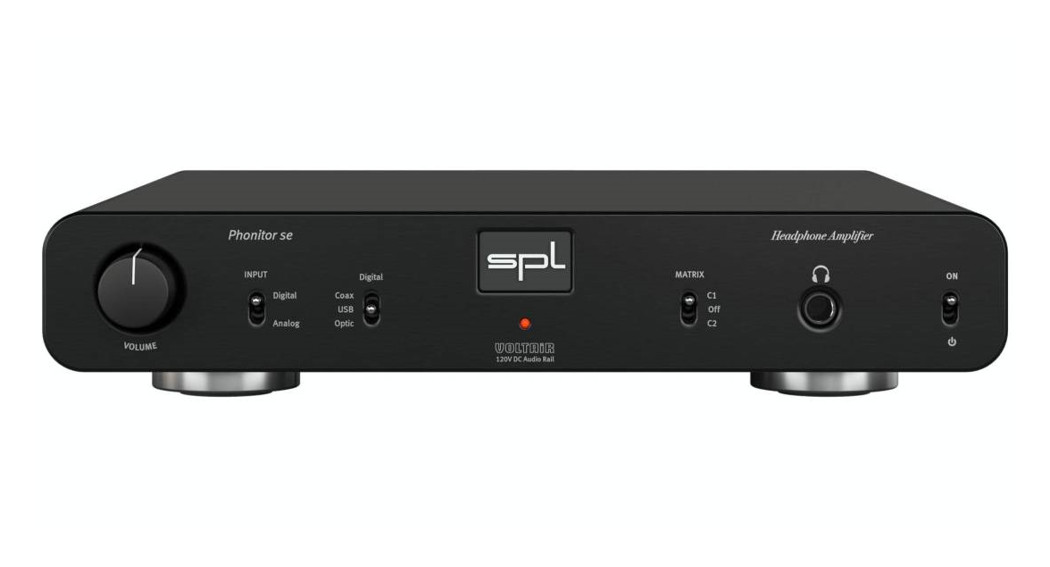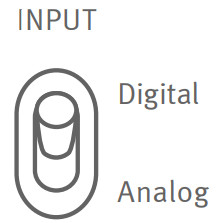
Professional FidelityMastering Grade ListeningPhonitor se – User ManualHeadphone Amplifier

 This User Manual is optimized for Acrobat Reader.Interactive buttons may not appear in other applications.
This User Manual is optimized for Acrobat Reader.Interactive buttons may not appear in other applications.
Welcomeand thank you for purchasing the Phonitor se.The Phonitor se is our entry model into the world of Voltaire headphone amplifiers. The Phonitor se has the same audio signal amplification as its bigger brothers Phonitor x and Phonitor xe and therefore offers the same sound experience. The DAC768xs is optionally available.Voltaire technology is what we also call the SPL 120V Rail Technology within the Professional Fidelity series. This makes the Phonitor se an outstanding device in terms of dynamic range, signal-to-noise ratio, and headroom delivering an exceptional sound experience with invincible serenity, transparency, and realness.

Getting started
Read thoroughly and follow the instructions as well as the security advices of the Quickstart which is enclosed in the scope of delivery! You can also download the Quickstart here.
By pressing the![]() -button you get to the table of contents.By pressing the
-button you get to the table of contents.By pressing the![]() -button you get to the front view of the unit.By pressing the
-button you get to the front view of the unit.By pressing the![]() -button you get to the rear view of the unit.By pressing the
-button you get to the rear view of the unit.By pressing the![]() -button you get to the bottom view of the unit.By pressing the
-button you get to the bottom view of the unit.By pressing the -button you get to the previous content.
-button you get to the previous content.
Front view

Rearview
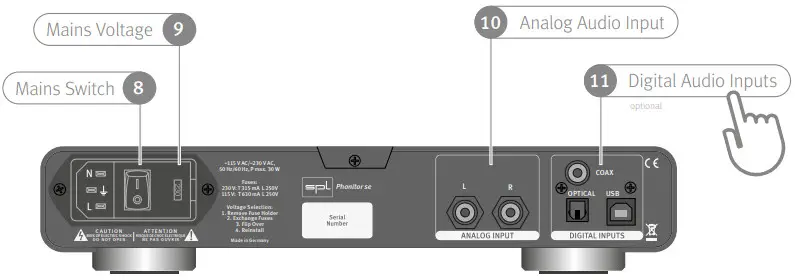
Bottom view
DIP switches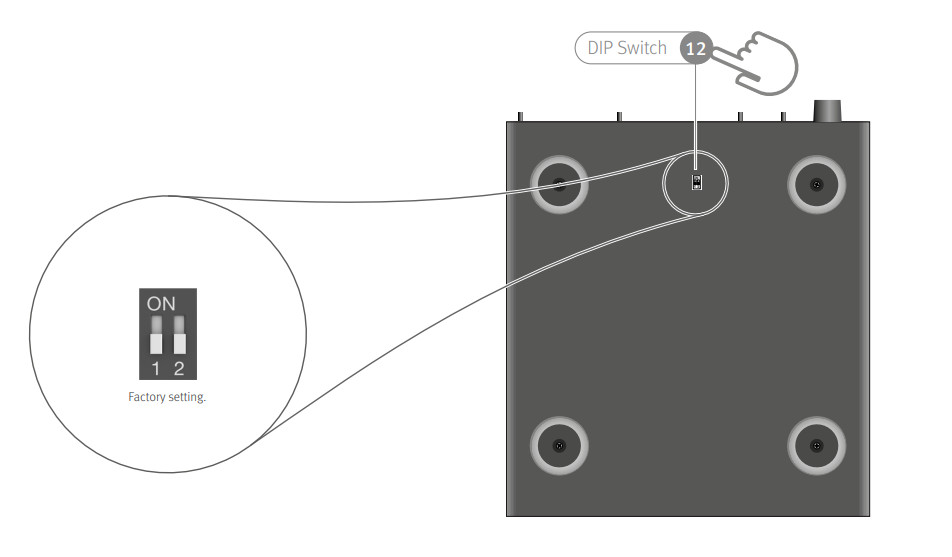
Voltaire – 120V Rail TechnologyVoltaire is the synonym for our 120V Rail Technology within the Professional Fidelity series. The audio signals are processed with an unequalled +/-60V DC, which corresponds to twice that of discrete operational amplifiers and four times that of semiconductor operational amplifiers.Voltaire Technology reaches outstanding technical and sonic performances. Technically especially in terms of dynamic range and headroom and sonically especially in reproducing the finest details and delivering a totally relaxed sounding audio experience. Music sounds absolutely natural.
SPL’s 120V Rail Technology is the internal audio processing voltage (+/- 60V DC).It is not to be confused with the external mains voltage (e.g. 115V or 230V AC).
Comparisons
These diagrams show how our Voltaire Technology compares to other circuits.The direct relation between operating level and maximum level is fundamental for the classification: the higher the operating level, the higher the maximum level a circuit can handle. And since virtually all essential acoustic and musical parameters depend on this relation, a higher operating voltage also has a positive impact on the dynamic range, distortion limit and signal-to-noise ratio.
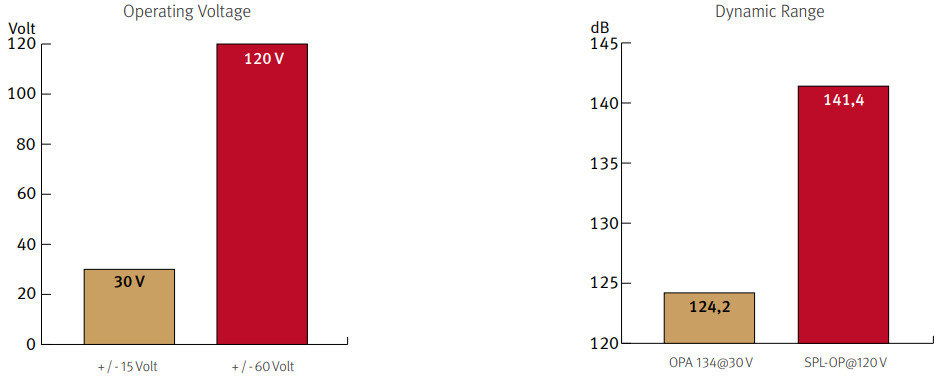
Do bear in mind that dB scales do not represent linear but rather exponential increases. A 3 dB increase corresponds to doubling the acoustic power, +6 dB correspond to twice the sound pressure level, and +10 dB correspond to twice the perceived loudness.When it comes to volume, the VOLTAiR Technology exhibits a performance, in regard to the maximum level and dynamic range, that is twice that of common components and circuits are given that its values are approximately 12 dB higher.THD measurements show a difference of more than 8 dB compared to the TL071 at 30 V — in terms of sound pressure level, which corresponds to an improvement of more than 130%. The operating level most commonly used for audio equipment is +/- 15 volts.
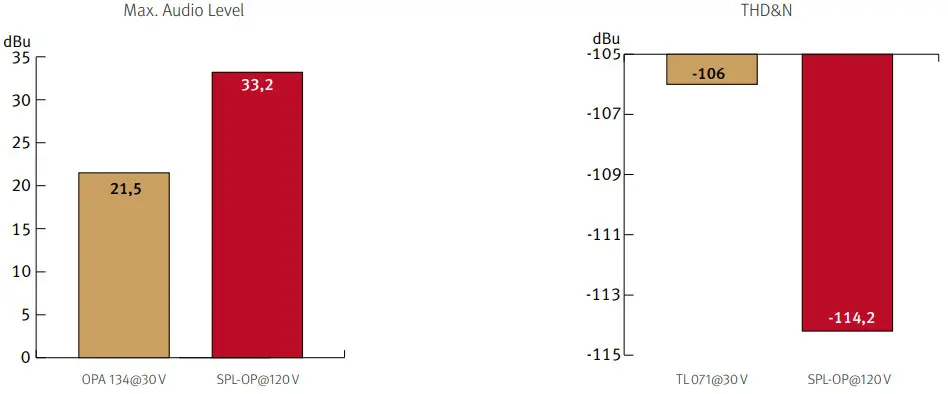
Phonitor Matrix
Basics of stereo listening
When listening to speakers sound coming from the right is not only perceived with the right ear (red line) but it is also perceived with the left ear (green line). The sensation is time delayed, lower in level and has a reduced frequency range (this applies to the left speaker accordingly).

It arrives later because the signal travels a distance of approx. 340 meters per second and the distance from the right speaker to the left ear is longer than it is to the right ear. It is quieter and does not deliver the full frequency range, because the signal of the right speaker does not directly arrive at the left ear but is partially reflected and absorbed by the head.Our brain determines the direction of the sound by perceiving the time delay (interaural time difference) and the level difference (interaural level difference).
Stereo listening with a “traditional“ headphone preamplifierWhen listening to music with a traditional headphone amplifier, the right ear only perceives the right signal (red line) and the left ear only perceives the left signal (green line). The delayed and quieter signal of the respective opposite side is missing. This unnatural sound irritates the ear and s stressful for our brain, becauseit constantly is busy trying to locate the direction of the sound.Besides, this super-stereo effect leads to an exaggerated stereo width. Instruments that are placed in the stereo field appear to be located much further outside than desired.These unnatural effects are corrected by the Phonitor Matrix.

How does the Phonitor Matrix work?In simple terms, the Phonitor Matrix creates a speaker-like listening experience on headphones. It calculates the time and level differences with their specific frequency responses to deliver a true rendition of a speaker playback.Because time and level differences are set like real loudspeaker placement, the brain is able to correctly identify the direction of the sound.You can perceive a speaker-like listening experience.All instruments appear at the correct position within the stereo image – just like it was intended when it was mixed in the studio. In comparison to a traditional headphone amplifier, it provides the best conditions to minimize hearing fatigue.

In DetailThe Phonitor se makes use of analog filter networks to create the interaural level and time differences. The time difference relates to the standard stereo speaker placement of 30°. The Phonitor se offers two crossfeed settings to create the interaural level difference.AngleThe Phonitor se has a fixed 30° speaker angle placement representing the standard speaker set-up.
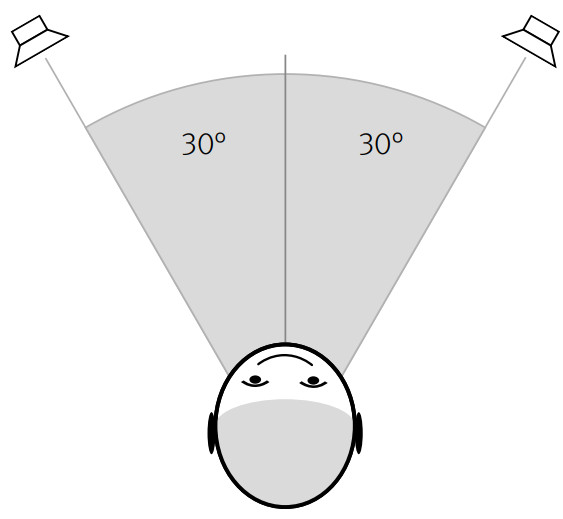
CrossfeedCrossfeed defines the interaural level difference. The two crossfeed values approximate the influences of room size, reflection, and absorption characteristics.

The interaural level difference and the interaural time difference are frequency-corrected because the sound is reflected and absorbed by the head in a non-linear fashion.
Phonitor Matrix presets
The Phonitor se of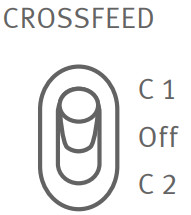 fers two presets. The Speaker Angle is fixed to 30°. For the Crossfeed there are two settings: C1 and C2.The value C1 has less crossfeed and therefore a lower time difference than C2.
fers two presets. The Speaker Angle is fixed to 30°. For the Crossfeed there are two settings: C1 and C2.The value C1 has less crossfeed and therefore a lower time difference than C2.
Source selection
Up to four audio sources can be connected to the Phonitor se.Connect your analog source to the RCA Input (10).Phonitor se can be equipped with a DA converter. With that installed the analog input is expanded by USB, coaxial, and optical digital stereo inputs (11).
- Select the analog or digital audio source by using the INPUT switch (4).
- You can select a digital audio source (USB, coaxial, optical) by using the DIGITAswitch (6).Set the INPUT switch to Digital.


Headphone output
- Turn down VOLUME before swapping headphones.
- Never insert a mono jack plug into the front panel stereo jack.
- Make sure that the headphones stereo jack is fully inserted.
- If you use an adapter from 3,5 mm to 1/4” (6,35 mm) on your headphone make sure that the adapter is fully screwed on respectively fully plugged in.
DIP switch
With the DIP switch (12) on the bottom the level of the headphone output can be increased:Level increase of the headphone outputBy using the DIP switch 1 you can increase the level of the headphone output to better feed power-hungry headphones.DIP switch 1: ON = The headphone output is boosted to +12 dB.DIP switch 2: n/a
Specifications
InputsRCA input
- Unbalanced
- Impedance: 20 kohms
- Max. Input level: +32.5 dBu
Digital inputs (optional DAC 768xs) / sample rates
- Coaxial SPDIF (RCA) – sample rates PCM (kHz): 44.1, 48 , 88.2, 96, 176.4, 192
- Optical TOSLINK (F06) – sample rates PCM (kHz): 44.1, 48 , 88.2, 96/ with Glass fibre <1m: 176.4/192 kHz
- USB (B), PCM sample rates: 44.1, 48 , 88.2, 96, 176.4, 192, 352.8, 384, 705.6, 768USB (B), DSD over PCM (DoP), sample rates: 2.8 (DSD64), 5.6 (DSD128), 11.2 (DSD256) MHz
Outputs
Standard headphone output Warning: Never connect a mono jack cable to the standard headphone output (front panel stereo jack).Make sure that the stereo jack is fully inserted, otherwise, a short circuit might damage the headphone amplifier!
Warning: Never connect a mono jack cable to the standard headphone output (front panel stereo jack).Make sure that the stereo jack is fully inserted, otherwise, a short circuit might damage the headphone amplifier!
- 6.35 mm TRS connector
- Pin wiring: Tip = Left, ring = right, sleeve = GND
- Source impedance: 0.18 ohm
- Damping factor (40 Ω): 180
- Frequency range ( -3 dB): 10 Hz to 300 kHz
- Crosstalk (1 kHz): -90 dB
- THD & N (10 Hz – 22 kHz, 0 dBu): 0.00091%
- Noise (A-weighted): -103 dB
- Output power (1 kHz, 1% THD, 600 Ω): 2 x 2.7 W
- Output power (1 kHz, 1% THD, 300 Ω): 2 x 5 W
- Output power (1 kHz, 1% THD, 32 Ω): 2 x 1 W
- Dynamic range: 135.5 dB
Internal operating voltages
- Operating voltage for analog audio: +/- 60 V
- Operating voltage for relays and LEDs: 12 V
- Operating voltage for DAC768xs: +7 V, +3.3 V
Power supply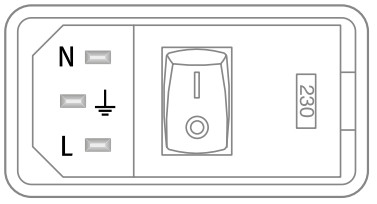
- Mains voltage (switchable): 230 V AC / 50 Hz or 115 V AC / 60 Hz
- Fuses: 230 V: T 315 mA; 115 V: T 630 mA
- Power consumption: max 30 VA
- Stand-by power consumption: 0.3 W
Dimensions (incl. feet)
- (WxHxD) 11 x 2.24 x 13 in (278 x 57 x 330 mm)
Weight
- 6.17 lbs (2.8 kg), unit only
- 8.6 lbs (3.9 kg), shipping
Important Notes
Version 1.0 – 08 /2020Developer: Bastian NeuThis manual includes a description of the product but no guarantee as for specific characteristics or successful results. Unless stated otherwise, everything herein corresponds to the technical status at the time of delivery of the product by SPL electronics GmbH. The design and circuitry are under continuous development and improvement. Technical specifications are subject to change.© 2020 SPL electronics GmbH. This document is the property of SPL and may not be copied or reproduced in any manner, in part or fully, without prior authorization by SPL. Sound Performance Lab (SPL) continuously strives to improve its products and reserves the right to modify the product described in this manual at any time without prior notice. SPL and the SPL Logo have registered trademarks of SPL electronics GmbH. All company names and product names in this manual are the trademarks or registered trademarks of their respective companies.
Declaration of CE Conformity
 The construction of this unit is in compliance with the standards and regulations of the European Community.
The construction of this unit is in compliance with the standards and regulations of the European Community.

[xyz-ips snippet=”download-snippet”]

